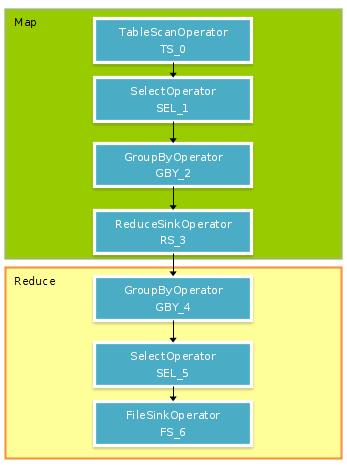hive------ Group byjoindistinct等实现原理
Posted 吊车尾88
tags:
篇首语:本文由小常识网(cha138.com)小编为大家整理,主要介绍了hive------ Group byjoindistinct等实现原理相关的知识,希望对你有一定的参考价值。
1. Hive 的 distribute by
Order by 能够预期产生完全排序的结果,但是它是通过只用一个reduce来做到这点的。所以对于大规模的数据集它的效率非常低。在很多情况下,并不需要全局排序,此时可以换成Hive的非标准扩展sort by。Sort by为每个reducer产生一个排序文件。在有些情况下,你需要控制某个特定行应该到哪个reducer,通常是为了进行后续的聚集操作。Hive的distribute by 子句可以做这件事。
// 根据年份和气温对气象数据进行排序,以确保所有具有相同年份的行最终都在一个reducer分区中
from record2
select year, temperature
distribute by year
sort by year asc, temperature desc;
2. Distinct 的实现
准备数据
语句
SELECT COUNT, COUNT(DISTINCT uid) FROM logs GROUP BY COUNT;hive> SELECT * FROM logs;
OK
a 苹果 3
a 橙子 3
a 烧鸡 1
b 烧鸡 3
hive> SELECT COUNT, COUNT(DISTINCT uid) FROM logs GROUP BY COUNT;根据count分组,计算独立用户数。
计算过程
1. 第一步先在mapper计算部分值,会以count和uid作为key,如果是distinct并且之前已经出现过,则忽略这条计算。第一步是以组合为key,第二步是以count为key.
2. ReduceSink是在mapper.close()时才执行的,在GroupByOperator.close()时,把结果输出。注意这里虽然key是count和uid,但是在reduce时分区是按count来的!
3. 第一步的distinct计算的值没用,要留到reduce计算的才准确。这里只是减少了key组合相同的行。不过如果是普通的count,后面是会合并起来的。
4. distinct通过比较lastInvoke判断要不要+1(因为在reduce是排序过了的,所以判断distict的字段变了没有,如果没变,则不+1)
Operator
Explain
hive> explain select count, count(distinct uid) from logs group by count;
OK
ABSTRACT SYNTAX TREE:
(TOK_QUERY (TOK_FROM (TOK_TABREF (TOK_TABNAME logs))) (TOK_INSERT (TOK_DESTINATION (TOK_DIR TOK_TMP_FILE)) (TOK_SELECT (TOK_SELEXPR (TOK_TABLE_OR_COL count)) (TOK_SELEXPR (TOK_FUNCTIONDI count (TOK_TABLE_OR_COL uid)))) (TOK_GROUPBY (TOK_TABLE_OR_COL count))))
STAGE DEPENDENCIES:
Stage-1 is a root stage
Stage-0 is a root stage
STAGE PLANS:
Stage: Stage-1
Map Reduce
Alias -> Map Operator Tree:
logs
TableScan //表扫描
alias: logs
Select Operator//列裁剪,取出uid,count字段就够了
expressions:
expr: count
type: int
expr: uid
type: string
outputColumnNames: count, uid
Group By Operator //先来map聚集
aggregations:
expr: count(DISTINCT uid) //聚集表达式
bucketGroup: false
keys:
expr: count
type: int
expr: uid
type: string
mode: hash //hash方式
outputColumnNames: _col0, _col1, _col2
Reduce Output Operator
key expressions: //输出的键
expr: _col0 //count
type: int
expr: _col1 //uid
type: string
sort order: ++
Map-reduce partition columns: //这里是按group by的字段分区的
expr: _col0 //这里表示count
type: int
tag: -1
value expressions:
expr: _col2
type: bigint
Reduce Operator Tree:
Group By Operator //第二次聚集
aggregations:
